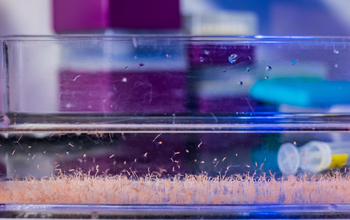Multimedia Gallery
Tracking neural activity, muscle movement in hydra (Image 4)
Rice University electrical and computer engineer Jacob Robinson and his lab have developed methods to corral tiny, squid-like hydra to perform the first comprehensive characterization of relationships between neural activity and muscle movements in the animals. [Image 4 of 4 related images. Back to Image 1.]
More about this image
Jacob Robinson, an electrical and computer engineering assistant professor, and his team have developed methods to corral tiny, squid-like hydrae and perform the first comprehensive characterization of the relationships between neural activity and muscle movements in these creatures. Hydra are squid-like creatures with remarkable regenerative abilities. If you cut one in two, you get hydrae. And each one can eat animals twice its size.
To reveal the basic neural patterns that drive the activities of freshwater Hydra vulgaris, the researchers immobilized the animals in narrow, needle-laden passages; dropped them into arenas about one-tenth the size of a dime; and let them explore wide-open spaces. They expect their analysis will help them identify patterns that have been conserved by evolution in larger brain architectures.
Using a microfluidics -- the manipulation of fluids and their contents at small scales -- platform, the lab sequestered a single hydra for up to 10 hours to study neurological activity during distinct behaviors like body column and tentacle contraction, bending and translocation. Some of the hydrae were wild, while others were modified to express fluorescent or other proteins.
"If you look at them with the naked eye, they just sit there," Robinson said. "They’re kind of boring. But if you speed things up with time-lapse imaging, they’re performing all kinds of interesting behaviors. They’re sampling their environment; they’re moving back and forth." The lab is working on building a camera-laden array of microfluidic chips to produce time-lapse movies of up to 100 animals at once.
The lab developed Nano-SPEARs, microscopic probes that measure electrical activity in the individual cells of small animals, that allowed them to perform electrophysiology tests. The needles extend from the center of the hourglass-shaped capture device and penetrate a hydra’s cells without doing permanent damage to the animal.
The team used calcium-sensitive proteins to trigger fluorescent signals in the hydra’s cells and produced time-lapsed movies in which neurons lit up as they contracted. "We use calcium as a proxy for electrical activity inside the cell," Robinson said. "When a cell becomes active, the electrical potential across its membrane changes. Ion channels open up and allow the calcium to come in." With this approach, the lab could identify the patterns of neural activity that drove muscle contractions.
"Calcium imaging gives us spatial resolution, so I know where cells are active," he said. "That’s important to understand how the brain of this organism works."
With this and future studies, the team hopes to connect neural activity and muscle response to learn about similar connections in other members of the animal kingdom.
This research was supported in part by the National Science Foundation (NSF). To learn more, see the NSF News From the Field story Engineers track neural activity, muscle movement in ageless aquatic creatures. (Date image taken: unknown; date originally posted to NSF Multimedia Gallery: Dec. 11, 2018)
Credit: Jeff Fitlow/Rice University
Images and other media in the National Science Foundation Multimedia Gallery are available for use in print and electronic material by NSF employees, members of the media, university staff, teachers and the general public. All media in the gallery are intended for personal, educational and nonprofit/non-commercial use only.
Images credited to the National Science Foundation, a federal agency, are in the public domain. The images were created by employees of the United States Government as part of their official duties or prepared by contractors as "works for hire" for NSF. You may freely use NSF-credited images and, at your discretion, credit NSF with a "Courtesy: National Science Foundation" notation.
Additional information about general usage can be found in Conditions.
Also Available:
Download the high-resolution JPG version of the image. (3.6 MB)
Use your mouse to right-click (Mac users may need to Ctrl-click) the link above and choose the option that will save the file or target to your computer.



